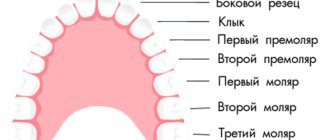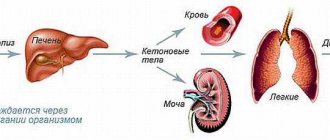Bad breath is one of the most common complaints with which patients turn not only to the dentist, but also to other specialists (therapist, gastroenterologist, otolaryngologist), since such a problem can be a consequence of a number of diseases.
In scientific and medical circles, special terms are used to refer to bad breath, such as “halitosis” or “ozonostomia”. In ICD-10, bad breath is classified as a clinical symptom related to gastrointestinal diseases and abdominal pathologies, and is designated by code R19.6.
Putrid odor from teeth and gums can also be the result of active growth of anaerobic bacterial flora in the mouth due to infectious and inflammatory dental diseases. If a sharp, unpleasant odor appears from the gums (in the absence of other symptoms), a dental examination and oral sanitation are recommended.
If the problem does not disappear after this, a comprehensive examination of the ENT organs and digestive tract is necessary.
Why does my breath smell bad?
The mechanism of formation of bad breath is represented mainly by the growth of pathogenic flora on the mucous membranes of the gums and the inner surface of the cheeks.
The reasons for this may be different, but the basis of the pathogenetic changes is a violation of the qualitative and quantitative relationship between pathogenic bacteria (some strains of streptococci, Escherichia coli and Pseudomonas aeruginosa, the bacteria Bulleidia moorei) and aerobes that can suppress their activity.
Aerobic microorganisms are microorganisms whose ability to function is active only when exposed to atmospheric oxygen. Both microorganisms are opportunistic for humans and can cause a number of serious diseases (tuberculosis, Lyme disease, streptococcal pharyngitis, etc.), but it is their balance that allows maintaining a normal level of acidity and local immunity of the mucous membranes in the oral cavity.
A pungent odor from teeth and gums in a person who does not suffer from pancreatitis, gastritis, cholecystitis and other pathologies of the digestive system and abdominal organs occurs as a result of excessive synthesis of volatile compounds that can penetrate into the environment in significant concentrations. Such compounds are secreted by representatives of the anaerobic flora, feeding on food debris contained in dense dental plaque and deposits, therefore, one of the leading factors in the development of ozonostomy is rightly considered to be the low quality of oral hygiene.
What could the smell be?
The cause of halitosis can be guessed by the specific odor a person emits into the environment.
Types of volatile compounds and their relationship with bad breath
| Substances produced by bacteria in the mouth | What smell do they have? |
| Methanethiol (poisonous, colorless gas) | Rotten cabbage (even in minimal concentrations). |
| Allyl mercaptan | Garlic, rotten onions. |
| Propyl mercaptan | Pungent smell of rot. |
| Dihydrosulfide | Rotten eggs. |
| Dimethyl sulfide (organic volatile liquid) | Pungent smell of sulfur and petroleum products (gasoline). |
| ?-pentamethylenediamine | The smell of a decomposing corpse, the pungent smell of urine. |
| Indole and its derivatives | Naphthalene. |
| Ammonia derivatives | Feces (feces). |
| 1,4-diaminobutane | Spoiled meat. |
| Dimethylamine | Rotten fish. |
| Methylbutanoic (isovaleric) acid | Sour milk. |
Note! All the compounds listed in the table are produced primarily by pathogenic microorganisms, so dentists cite poor-quality hygienic care and dental diseases (especially chronic ones) as the main causes of unpleasant gum odor.
What is bleeding gums?
If, when brushing your teeth, the paste on the brush becomes pinkish, this may indicate bleeding gums. According to the frequency of manifestation, it can be situational or chronic. In the first case, blood on the mucous membrane appears as a result of mechanical damage and usually does not cause alarm. If the gums bleed regularly, there is a high probability of infection and inflammation of the soft tissue.
Statistics show that almost all people aged 30 years and older experience inflammatory processes in the periodontal area. The reason lies in the imbalance of microorganisms, which occurs against the background of poor ecology, poor hygiene, poor nutrition and bad habits. Under the influence of external factors, the immune defense of the mucous membrane deteriorates, which contributes to the development of dental diseases.
If a person experiences bleeding when brushing his teeth, doctors recommend not leaving the pathology unattended. The problem is not only often accompanied by discomfort and bad breath, but if left untreated, it leads to many complications, including tooth loss.
Dental reasons
If a putrid odor from the gums appears suddenly, the first thing to do is consult a dentist and rule out the presence of caries, inflammatory processes in the gingival and periodontal tissues, hilar cysts and granulomas, and abscesses. It is almost impossible to independently identify the source of bad breath (gums or teeth), so dental diagnostics are carried out comprehensively and often include not only a visual examination using a medical mirror, percussion of the teeth (if periodontitis is suspected), but also an X-ray or computed tomographic examination.
The causes that can provoke halitosis include a number of pathologies and diseases.
- Caries. This is the most common disease among all age populations, in which the hard tissues of the tooth are affected and necrotically modified. The causes of caries are dysbacteriosis, poor hygiene, lack of sufficient preventive measures, chronic infections (especially diseases of the ENT organs). A pungent odor from the gums and teeth with stage 3-4 caries appears in almost 100% of patients and is perceived by others as the smell of rotting food, feces or urine.
- Inflammatory and infectious gum diseases. This group includes infectious and non-infectious pathologies of the oral cavity, in which soft tissues (gums and tongue) are involved in the inflammatory process. These are stomatitis, gingivitis, desquamative glossitis, pharyngomycosis of the oral cavity and other diseases whose pathogenesis is based on catarrhal, herpetic, exfoliative, traumatic or eczematous inflammation.
- Periodontal diseases. Periodontium is a special type of fibrous collagen fibers with a low degree of elasticity that fill the space between the alveolar bone and the hilar cementum. One of the complications of periodontitis and periodontitis is the formation of periodontal (periodontal) pockets, into which food can become clogged, undergoing processes of fermentation, fermentation and decay. It is the decay products that cause the putrid odor from the gums in this case.
- Abscesses, cysts of the gums, tooth roots or dental alveoli. Bad breath with cysts may indicate that the cavity is inflamed and filled with purulent exudate, which can be a source of hematogenous spread of infection throughout the body. Treatment for a purulent cyst or abscess is surgical (followed by antibiotic therapy).
One of the causes of bad breath can also be xerostomia, a pathology of the salivary glands, in which an insufficient amount of saliva is produced in a person’s mouth. Saliva is necessary not only to maintain normal levels of moisture and acidity, but also for the primary processing of incoming food due to the action of digestive enzymes. If there is not enough saliva, food enters the stomach poorly processed, which can cause indigestion and the release of bad-smelling gases and acids that rise up the esophagus back into the oral cavity.
Important! If the patient has undergone orthodontic treatment (dental implantation, installation of braces, etc.), in addition to a dental examination, an orthodontist consultation is also indicated to exclude galvanic syndrome - poor survival or intolerance of installed dentures.
How to get rid of bad breath
Some sensitive issues are not usually discussed even with close relatives. People tend to turn a blind eye and ignore them for a long time, especially if the solution requires consulting a specialist. In such a situation, many choose the path of least resistance - folk recipes and various remedies that can be used at home. As a rule, they are ineffective, but such a choice does not require much effort and suits the person until the problems reach frightening proportions.
The scenario described above is more than typical for the symptom discussed in this publication. Bad breath is not something to discuss. The rules of good manners do not allow others to point out the problem, and the person himself prefers to think that it is not so big.
In everyday life, this symptom of chronic somatic diseases or dental pathology is often described with the vague formulation “bad breath.” Doctors and dentists use the more correct and unambiguous term “halitosis.” Breath with a “smell” most often indicates the development of certain diseases. It is not necessary to discuss the situation with loved ones, but if bad breath appears, it is extremely important to undergo a diagnosis that will reveal the true causes of halitosis.
Causes
Not all causes of halitosis are a cause for concern. In a certain percentage of cases, it’s all about the banal consumption of certain foods or drinks that have pronounced aromatic properties. An example would be garlic, onions or fish - foods with a specific aroma. Exogenous causes include smoking. Tobacco often causes bad breath, which the smoker himself does not even notice. But these reasons are obvious, and it’s easy to fight them. It is more difficult (and more important!) to solve a problem that has no obvious causes.
In order to get rid of bad breath once and for all, which has been bothering you for a long time and is not associated with exogenous causes, it is important to find out what causes its appearance. Endogenous (internal) causes can be divided into two categories.
The first category is diseases of the oral cavity. It is oral disease that is the root of the problem in the vast majority of people with halitosis. Dental diseases that can lead to bad breath are discussed in more detail in the next section of the publication.
The second group of causes is formed by chronic diseases of the stomach, other parts and organs of the digestive system, and diseases of the endocrine organs. The greatest danger is diabetes mellitus, both type 1 and type 2. This endocrine pathology is characterized by the appearance of an “acetone” odor. It is caused by metabolic disorders: the patient’s body increases the formation of ketone bodies (organic compounds), which are excreted through the lungs and give the breath a specific “acetone” smell.
Parents should be wary of this symptom (smell of acetone). If a child develops a symptom, you should immediately consult a specialist and undergo an examination, a mandatory element of which is a glucose tolerance test and a blood sugar test.
Note that in rare cases, the unpleasant odor of acetone is associated with dietary habits. In recent years, the so-called ketone diet, which requires maximum restriction of carbohydrate intake, has become very popular. Its goal is to transition the body into a state of acidosis, in which there is an increased formation of ketone bodies. Because these organic substances are partially eliminated through the lungs, followers of the ketone diet often face the problem of bad breath.
Halitosis in dental pathology
Gastrointestinal diseases (gastritis, stomach ulcers), diabetes mellitus or the ketone diet are conditions that people are generally well aware of. The only exception is undiagnosed diabetes, so if the smell of acetone appears, it is extremely important to promptly seek qualified help.
If bad breath appears against the background of “complete well-being,” its causes should be sought in dental pathology. It is very important to understand that oral diseases are the main causes of halitosis in people without chronic endocrine or somatic pathology. If you are interested in the question of how to get rid of bad breath, carefully study this section of the publication. This way you can avoid common mistakes, forget about the problem forever and, most importantly, keep your teeth intact and healthy.
In diseases of the oral cavity (often they are not diagnosed, that is, the person may not be aware of the problem), the unpleasant odor has a specific, slightly “putrid” character. At first, a person notices the symptom, mainly after sleep, before carrying out morning hygiene procedures. Then the problem of bad breath becomes a constant companion, which causes serious concern.
Caries
What diseases provoke the appearance of halitosis? In the first place is caries. Carious tooth damage is accompanied by the development of pathogenic microflora. Bacteria produce toxins that cause inflammation in the oral cavity. In addition, bacteria emit gaseous substances, which themselves have an unpleasant odor.
The degree of carious lesion directly affects the severity of halitosis. The deeper the microorganisms penetrate into the tooth, the stronger the unpleasant odor. The problem can only be solved by complete removal of the affected tissue with restoration of the defective tooth.
The only right decision is to seek help from a specialist without any extra thought or doubt. Make an appointment with your dentist, otherwise the tooth will continue to decay. Once a critical amount of living tissue has been destroyed, restoring the tooth will require expensive orthopedic treatment.
Periodontitis, fistula in the gum
Purulent inflammation around the root apex is the result of untreated caries and pulpitis. An apical abscess can manifest itself as a symptom such as the formation of a fistula on the gum. A fistula is the external opening of a canal connecting a cyst to the oral cavity. Through the fistula, pus is released, which is accompanied by the appearance of a characteristic unpleasant odor.
Poor hygiene
Are there other causes of halitosis besides tooth decay? Undoubtedly. Bad breath can be the result of poor oral care. If a person brushes their teeth sporadically, or does it too quickly or not thoroughly enough, a bacterial film forms on the surface of the teeth. Over time, this soft film, which can be easily removed with a regular brush, becomes saturated with mineral salts. This forms hard stone on the teeth, which can no longer be removed with a brush.
The basis of dental plaque is bacteria, which release toxins and gaseous substances, causing inflammation of the oral mucosa. Due to these processes, the breath acquires an unpleasant odor.
Gingivitis, periodontitis
Hard dental plaque is a harbinger of dental caries and a number of other oral diseases. If you do nothing, sooner or later you will face more serious problems than halitosis. Many people begin to notice that their gums bleed during daily brushing. These are the first symptoms of gingivitis, in which an inflammatory process develops in the gum mucosa.
Gingivitis left untreated (or treated with home remedies that are ineffective) leads to the development of periodontitis, an oral disease that poses a real risk of tooth loss. At this point, many remember that it all started with poor hygiene and bad breath, and the problem was easily solved by hygienic teeth cleaning in the dental office.
How to get rid of bad breath?
Even today, in the age of maximum availability of information about various symptoms, their causes and treatment methods, many people continue to pose the question differently: how to get rid of bad breath at home? Is this possible, and if not, why?
Fresh breath, which is actively advertised by manufacturers of toothpastes and chewing gums, is an indicator of good hygiene and overall health of the oral cavity and teeth. Breathing is a kind of litmus test that allows us to understand how healthy we are and how attentive we are to personal hygiene.
Bad breath is a red flag and an indicator of serious problems. Problems not only with hygiene, but with oral health. It is possible to mask halitosis by chewing gum or regularly rinsing the mouth with special solutions, but this will not solve the problem.
How to eliminate bad breath if it is caused by stone formation with activation of pathogenic microflora? Stone is a mineralized plaque that is firmly fixed to the enamel. It is not possible to remove the stone yourself. This can only be done by a dentist using special equipment. Ultrasonic cleaning is used to remove tartar. Another technology for removing deposits is Air Flow.
Professional teeth cleaning is the most effective means of preventing caries, periodontitis, gingivitis and other dental diseases!
For gingivitis, professional teeth cleaning to remove hard deposits is also a mandatory stage of treatment. After cleaning the teeth, anti-inflammatory therapy is prescribed for 10 days. The patient should rinse the mouth with antiseptic solutions several times a day. After rinsing, special dental gels with an anti-inflammatory effect are applied to the gums.
In case of periodontitis, the above stages of treatment do not lose their relevance, but teeth cleaning is complicated by the fact that it is necessary to remove stone from periodontal pockets. This is difficult to do; the treatment is carried out by a doctor with a narrow specialization - a periodontist. In addition to anti-inflammatory drugs, antibiotics are often prescribed.
How to remove bad breath caused by caries? If the cause of “stale breath” is caries, there is no need to talk about the effectiveness of any methods for use at home. Science has not yet known cases of self-healing from this disease. The person who finds a way to cure tooth decay without the help of a dentist should be awarded a Nobel Prize.
Caries treatment is carried out in a dental clinic. The dentist removes all tissues affected by the carious process. If this is not done, a source of infection will remain, which will lead to further decay and destruction of the tooth.
After removing the carious defect, the tooth is restored with a composite polymer (a filling is placed). If caries is complicated by the development of pulpitis or periodontitis, the stage of depulpation, sanitation and subsequent sealing of the canals is added to the treatment protocols. Depulpation with root canal sealing increases the duration and cost of treatment, but it is necessary if you want to save the tooth.
To cure caries quickly and without extra costs, contact your dentist when the first symptoms appear, or better yet, schedule a consultation every six months for a preventive examination and professional teeth cleaning.
Bad breath after caries treatment
Some patients develop bad breath after caries treatment. As a rule, bad breath is accompanied by another symptom - local pain in the area of the projection of the treated tooth or the formation of a fistula in the gum. The condition should be considered as a complication that indicates poor quality dental care.
The cause of post-filling pain is the re-development of the infectious process in the deep tissues. This is caused by incomplete removal of carious tissues or poor isolation of the tooth during filling or sealing of canals. In the first case, pathogenic microorganisms remain in the tooth, in the second, saliva and bacteria get under the filling, which become a source of secondary infection.
To remove bad breath in such a situation, you need to undergo repeated treatment with unfilling of the root canals and sanitization of the source of infection. To avoid complications, contact dental centers with a good reputation and trust your oral health to qualified, conscientious and experienced specialists.
Prevention
If there is no unpleasant odor, its occurrence can be easily prevented. High-quality and regular cleaning of the oral cavity is enough. After eating, it is important to remove the smallest particles of food from the interdental spaces. To do this, you need to use dental floss, and then clean the lingual and outer surfaces of the teeth with a good brush, preferably with stiff bristles.
People with orthopedic (crowns, bridges) or orthodontic (braces) structures, as well as anomalies in the location of teeth in the form of crowding, may require additional tools for personal hygiene. Dentists strongly recommend that such patients purchase an irrigator with special attachments that ideally cleans crowns, braces, narrow interdental spaces and gum pockets.
It is good practice to have your teeth professionally cleaned with Air Flow regularly at your dentist's office to help prevent plaque from forming. Once every six months you need to make an appointment for preventive examinations with a dentist to detect caries at an early stage.
To receive individual recommendations regarding solving the problem of “stale breath,” sign up for a consultation with a medical dentist (Moscow).
What other reasons can cause ozonostomy?
If an examination by a dentist does not reveal any diseases or pathologies, the doctor will refer the patient to specialized specialists to determine the possible causes. These may include:
- pathologies of the digestive system and abdominal organs (pancreatitis, cholecystitis, gastritis, duodenitis, chronic colitis, irritable bowel syndrome, gastroduodenitis);
- untreated or recurrent infectious diseases of the nasopharynx and oropharynx (tonsillitis, sinusitis, laryngitis, pharyngitis);
- kidney pathologies accompanied by partial dysfunction of the renal system;
- diabetes mellitus (the smell of urine and acetone from the mouth is one of the signs of a lack of insulin);
- long-term use of certain medications that can cause xerostomia (proton pump blockers, heartburn medications, alpha-agonists, etc.);
- abuse of foods with a high content of purines and phytoncides (onions, garlic, green onions, all varieties of cabbage, sorrel);
- smoking (especially if a person smokes more than 10 cigarettes per day).
Often the unpleasant smell of sour milk or rotten eggs appears in women on diets. A prolonged absence of food in the stomach provokes increased activity of parietal cells, which are responsible for the production of hydrochloric acid. As a result, a colorless gas accumulates in the stomach, which is a compound of hydrogen and sulfur and has the characteristic smell of rotten eggs. If food does not enter the stomach, this gas rises to the top and is released into the environment through the mouth when a person talks, yawns or sneezes.
People who are susceptible to emotional instability and are often in a state of prolonged stress experience unpleasant gum odor 2.1 times more often than their peers who are in an emotionally stable state.
Important! A constant smell of rot, feces or urine from the mouth, especially if it intensifies or is combined with other symptoms (sore throat, sensation of a foreign body in the pharynx and esophagus, nausea, discomfort in the stomach, etc.), may be a manifestation of malignant tumors digestive system or larynx. Consultation with an oncologist is indicated in cases where it is not possible to get rid of the unpleasant odor within 3 months, despite a complete examination, sanitization of foci of chronic infection and adherence to personal hygiene measures.
Diagnosis at home
The patient himself very often does not notice that his breath smells bad, and the people around him are embarrassed to say so, for fear of offending a loved one. To independently assess the freshness of your breath and the intensity of odors, you can perform one of the tests below. All of them are simple to perform and do not require the help of outsiders or any special equipment or tools.
Method 1
This method requires floss (dental floss) without adding flavoring or coloring additives.
- Clean the interdental spaces using the classic method. To assess the freshness of breath, it is necessary to treat molars (molars).
- After the procedure, carefully examine the color of the floss. The presence of a yellowish, light brown or creamy tint indicates a large amount of bacterial plaque on the inner surface of the tooth enamel. If a pinkish tint appears on the thread, you should check the condition of your gums.
- The smell can be assessed 20-30 seconds after the procedure.
The test cannot be considered reliable if colored or scented thread was used.
Method 2
To carry out this test, you need to use a soft silicone spoon or wooden spatula (can be purchased at a pharmacy).
Using a spatula, remove the plaque from the middle part of the tongue, then wait 10-15 seconds and evaluate the quality and intensity of the smell.
Method 3
This method is the simplest and allows you to carry out express diagnostics in 1 minute, from anywhere. To do this, wash your hands thoroughly with soap and lick the outer surface of your hand (near the thumb) or wrist. You can evaluate the result in 40-50 seconds.
How does a dentist diagnose?
To identify signs of ozonostomy, dentists use the organoleptic diagnostic method. Indicators are measured using special instruments and analyzed in accordance with established standards.
To ensure that the test result is as reliable as possible, 12-20 hours before the doctor’s visit, the patient is recommended to:
- stop smoking and chewing gum;
- do not use hot spices, seasonings, seasonings and products containing large amounts of flavorings, flavor enhancers and dyes;
- discontinue antimicrobial treatment (48 hours before the test), if possible;
- Do not use tooth balms or rinses.
Note! You cannot brush your teeth before the procedure. The last brushing of teeth is allowed 8-10 hours before the test.
How to prevent oral problems from developing
If the patient has a problem, the doctor will definitely remove the crown, assess the degree of tooth decay, and choose the most effective treatment method. In addition to filling the canals and eliminating the inflammatory process, it may be necessary to remove plaque. When the tooth and soft tissues are restored, you can begin installing the crown again.
In cases where it is not possible to immediately seek help from a doctor, it is recommended to rinse your mouth with an infusion of herbal decoction. A decoction of chamomile, mint or sage perfectly relieves the inflammatory process for a while.
Since it is impossible to avoid therapeutic methods of treatment, you should seek help from a specialist at the first opportunity. The doctor will be able to select alternative materials for making a new crown, suggest other methods of prosthetics, and also select the best methods for treating diseases associated with inflammation of the soft tissues.
How to deal with the smell?
Treatment of halitosis and its manifestations consists of complete sanitation of infectious foci. The patient is treated for carious cavities with the installation of fillings and cleaning of the canals. If the tooth cannot be saved, extraction is prescribed (installation of dentures is permissible only after high-quality sanitation and oral hygiene). For infectious or inflammatory pathologies, a course of local treatment (application, rinsing with antiseptics, instillation), antibiotic therapy and antimicrobial therapy is carried out.
For recurrent gingivitis, the doctor may prescribe Metronidazole at a dosage of 100-200 mg 2-3 times a day. The standard course of treatment is 7-10 days. In more severe cases, antibiotics are indicated - amoxicillin, tetracycline, cephalosporin. Local applications are made with medicinal ointments and gels, some of which can be placed directly into periodontal pockets (Cholisal, Metrogil Denta, Asepta, Kamistad).
For fungal infections (candidal stomatitis, pharyngomycosis), systemic and local antimycotics are used - Fluconazole, Candide, Miconazole. In all cases, rinsing with antiseptics (Miramistin, chlorhexidine, furatsilin solution) is indicated.
Important! To treat unpleasant odor caused by diseases of the digestive system, upper and lower respiratory tract, abdominal organs, complex medical, physiotherapeutic and surgical (if necessary) treatment is prescribed: rehabilitation of foci of chronic infection in case of sinusitis, pharyngitis, treatment of gastritis, correction of IBS.
Prevention
The main measure to prevent bad breath in patients of any age is high-quality oral hygiene and timely treatment of dental diseases. The tips and recommendations below can be used both to prevent halitosis and to improve the effectiveness of its treatment.
- It is necessary to carry out hygienic treatment of the oral cavity at least 2 times a day. You should brush your teeth immediately after waking up in the morning, and after your last meal in the evening.
- If you are prone to bleeding and the deposition of bacterial plaque, you should additionally use balms and rinses with medicinal herbs and natural antiseptics (Forest Balsam, Listerine, Asepta). Such products should be used in courses - 2-3 weeks every 3-4 months.
- Incorrect or irregular nutrition can provoke the appearance of an unpleasant odor, so it is important to adjust your diet and habits.
- After eating, you should rinse your mouth with boiled water so that there are no pieces of food left in it, which are a breeding ground for bacteria.
Persons who practice oral sex should brush their teeth (at a minimum, thoroughly rinse your mouth with water or mouthwash) after each contact.
Video - 10 ways to combat halitosis
Foul odor from gums is a common dental problem that can only be solved with an integrated approach. Treatment should begin with a visit to the dentist and a complete sanitation: removal of necrotic tissue, relief of inflammatory processes, extraction of teeth that cannot be treated or restored. If the cause of halitosis is diseases of the gastrointestinal tract or larynx, treatment also involves the sanitation of existing infectious foci. Any local remedies (oral sprays, rinses, chewing gums) only mask the problem for a short time, but do not solve it completely, creating conditions for the development of possible complications.
Signs of tooth decay under the crown
Tooth decay under the crown is a dangerous situation for the body. The process is accompanied by the proliferation of pathogenic flora. With the blood flow it enters all organs and systems.
Symptoms of tooth decay under a denture:
- halitosis – the appearance of an unpleasant odor;
- mobility of the dental structure;
- darkening of a molar, incisor or canine;
- taste of pus in the mouth;
- receding gums, exposing the neck of the tooth;
- tissue hyperemia, bleeding from the gums;
- pain when biting, temperature change.
Do not delay in seeing a doctor. The sooner you start treatment, the greater the chances of saving the tooth under the crown and preventing the development of complications. Price list with orthopedic services – follow the link.









